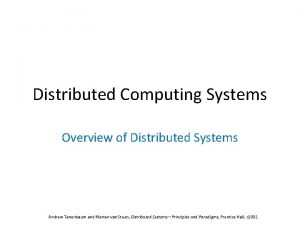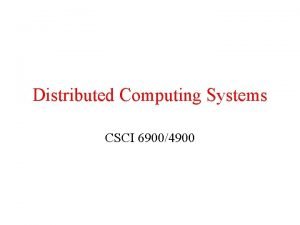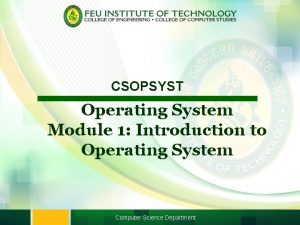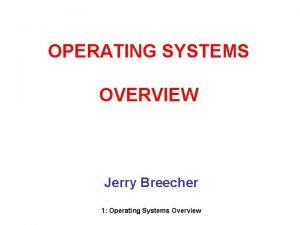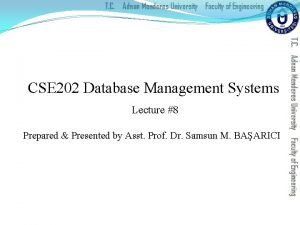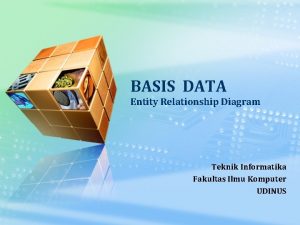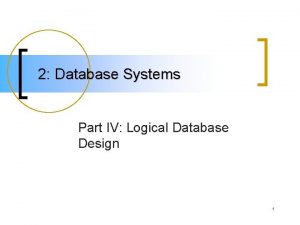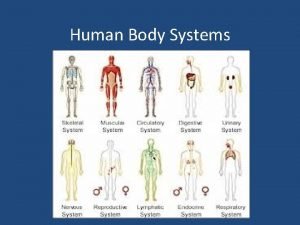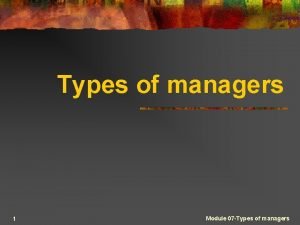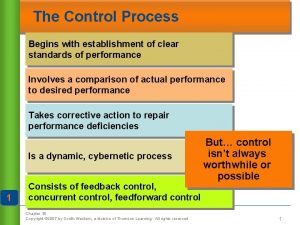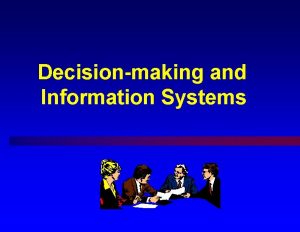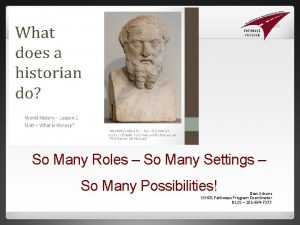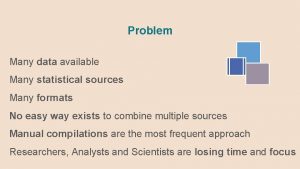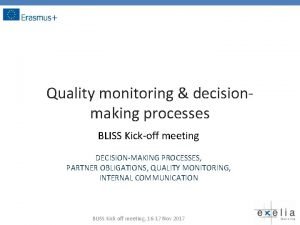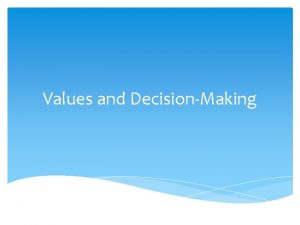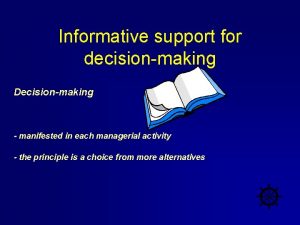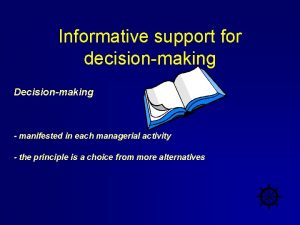Decisionmaking Systems Overview What managers do Decisionmaking Many

































- Slides: 33

Decision-making Systems

Overview What managers do? Decision-making Many views of MIS Types of MIS

What managers do? Regular meetings Travel Other meetings Phone calls Desk work

Managerial roles and IS support Role IS support interpersonal e-mail, video/teleconferencing, computer-mediated meetings informational TPS, MIS, EIS, OIS decisional DSS, GDSS, EIS, AI/ES

Decision-making Intelligence problem definition Design alternatives Choice resolution

Decision Support in Business Information Requirements of Decision Makers Decision Structure Unstructured Information Characteristics Ad Hoc Unscheduled Summarized Infrequent Forward Looking External Wide Scope Strategic Management ion o Inf s Executives & Directors cis Tactical Management De on ati rm Semi-Structured Business Unit Management Self-Directed Teams Structured Operational Management Prespecified Scheduled Detailed Frequent Historical Internal Narrow Focus Operating Management & Self-Directed Teams

Decision Support in Business Characteristics of Information Products n. Time Dimension n. Content Dimension n. Form Dimension

Decision Support in Business Decision Structured Decisions Semistructured Unstructed

Time horizon strategic tactical operational NOW weeks years 5 -7

Users' view

Federative view M A R K E T I N G P R O D U C T I O N F I N A N C E P E R S O N N E L Data base management system DATA BASE M A N A G E M E N T

Integrative view Functional areas Decision levels Data base management system


Types of Information Systems TPS MIS EIS DSS GDSS AI/ES transaction processing systems management reporting executive information systems decision support systems group decision support systems expert systems

Management Information Systems Management Reporting Alternatives Components of a Marketing Information CLIENTS System INTERNAL Sales Prospects and Rivals’ News DATABASES SERVER Rivals’ News and Company News Sales Prospects Rivals’ News Sales Prospects and Company News Customer Data Sales Data News Wires Company News The Server Filters Information Based on Users’ Custom Requirements Inventory Data Via the Internet Firewall

Decision type STRUCTURED Intelligence knowledge Design of all Choice steps TPS SEMI-STRUCTURED no knowledge of one or two steps DSS UNSTRUCTURED no knowledge of any of the steps EIS

DSS generators DSS tools technical support Specific DSS USERS DSS Generator intermediary DSS Builder toolsmith managers, manager users

Anatomy of a DSS model base data base DBMS MBMS DGMS DSS generator dialog, user interface users

Dialog styles n Basic types t t t Q&A - Question and answer Command language Menu Input Form/Output Form Input-in-Context-of-Output Pros and cons n Mixed dialogs n

Decision Support Systems Using Decision Support n What-if Analysis n Sensitivity Analysis n Goal-Seeking Analysis n Optimization Analysis

GDSS - Group Decision Support Systems TIME PLACE n DSS plus: ANY (asynch) SAME (synch) – Groupware n Facilities Decision frequency place SAME FACE-TO-FACE CONFERENCE (WEBTYCHO) ANY VIDEO/TELECONFERENCI NG VIRTUAL LAN decision high network Decision room WAN decision network Teleconferencing low close far

Executive Information Systems present information for top management H supports problem/opportunity discovery and assessment H is used for control and strategic planning n are multimedia systems n provide summary and detailed information, with the ability to "drill down" into the data n provide internal and external information n provide different time and space information n

Artificial Intelligence Overview of AI

Artificial Intelligence The Domains of AI Artificial Intelligence Cognitive Science Applications • Expert Systems • Learning Systems • Fuzzy Logic • Genetic Algorithms • Neural Networks • Intelligent Agents Robotics Applications • Visual Perception • Tactility • Dexterity • Locomotion • Navigation Natural Interface Applications • Natural Languages • Speech Recognition • Multisensory Interfaces • Virtual Reality

Expert systems. . . an intelligent computer program that uses knowledge and inference procedures to solve problems that require significant human expertise for their solution. The knowledge of an expert systems consists of facts and heuristics. Facts constitute the body of information publicly available and agreed upon by experts in a field. Heuristics are mostly private rules of good judgement that characterize expert-level decision making in a field. E. Feigenbaum, Stanford University

Artificial Intelligence Expert Systems The Expert System Software Expert Advice Inference User Interface Engine Programs Program Knowledge Base User Workstation Expert System Development Knowledge Acquisition Program Knowledge Engineering Expert and/or Knowledge Engineer Workstation

Use and development of ES n Expert systems products n Expert systems shells n Expert systems players knowledge user l knowledge engineer l domain expert l

Artificial Intelligence Virtual Reality (VR) • Computer Simulated Reality • Multisensory Input/Output Devices • Data Glove • Walker • Creating Telepresence With Sight, Sound, and Touch

Artificial Intelligence Virtual Reality (VR)

GIS n It is important to appreciate that GIS does not always provide exact answers to problems, but by identifying trends based on geography, GIS can reveal patterns that can help us make informed decisions. A GIS can improve decision-making; it cannot make decisions for us.

GIS Example: Emergency services By using the GIS as a computerized map, controllers of police vehicles and ambulances can instantly call up a detailed map of the area around an incident. By tracking the vehicles in real time and using route-finding GIS functions, the controller can identify the best vehicle to attend and give directions for the fastest way to the incident. They can even store historical information and look for incident patterns and black spots.

GIS Example: Supermarket locations Supermarket chains use GIS to help site new stores and to plan their distribution networks. By comparing how many people live within 15 -minutes drive time of a particular location with the number of supermarkets already trading in that area, the GIS can identify suitable locations with an optimized catchment area. Supermarket chains also use socioeconomic data to create profiles of the people in their catchment areas to help them understand which other parts of the country are likely to be successful growth areas.

Additional Readings n n n SDSS Virtual Teams Commerical GDSS An Expert systems Application DSS. . Application GIS Applications Neural Networks Negotaiation System Example Knowledge management: big challenges, big rewards New Directions in GDSS RMIS system provides Chubb customers with current data and extensive drill-down analysis
 Survey of household economics and decisionmaking
Survey of household economics and decisionmaking Distributed systems overview
Distributed systems overview Sap project systems overview
Sap project systems overview Introduction to distributed computing
Introduction to distributed computing Overview of operating systems
Overview of operating systems Operating system overview
Operating system overview Many buyers and sellers
Many buyers and sellers Er diagram many to many
Er diagram many to many Bookstore database design
Bookstore database design Difference between erm and erd
Difference between erm and erd Unary many to many
Unary many to many Contoh erd one to many
Contoh erd one to many Unary many to many
Unary many to many Many to many communication
Many to many communication Sqlbi many to many
Sqlbi many to many Unary relationship database
Unary relationship database Many sellers and many buyers
Many sellers and many buyers Human body systems
Human body systems Pure command system
Pure command system How many economic systems are there
How many economic systems are there How many types of farming systems are there
How many types of farming systems are there Decision support systems and intelligent systems
Decision support systems and intelligent systems Engineering elegant systems: theory of systems engineering
Engineering elegant systems: theory of systems engineering Embedded systems vs cyber physical systems
Embedded systems vs cyber physical systems Engineering elegant systems: theory of systems engineering
Engineering elegant systems: theory of systems engineering Strategic planner
Strategic planner Difference between entrepreneur and businessman
Difference between entrepreneur and businessman Types of managers
Types of managers Using math to define the foodservice industry
Using math to define the foodservice industry Balanced scorecard for airlines
Balanced scorecard for airlines Differentiate between entrepreneur and intrapreneur
Differentiate between entrepreneur and intrapreneur Introduction to management chapter 1 notes
Introduction to management chapter 1 notes Java focus listener
Java focus listener Managing marketing information
Managing marketing information

